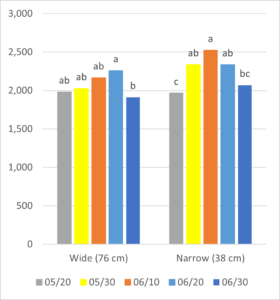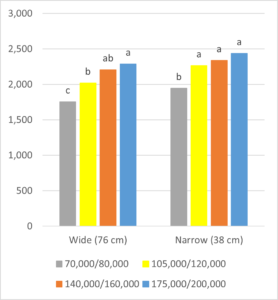Growers plant beans earlier in regions with fewer crop heat units (CHU) to avoid losses from fall frost, but the Ontario growing season is getting longer. Bean market classes grown, plant architecture and production practices (e.g. row width) are changing over time. Current guidelines provide recommendations for planting date and seeding rate independently, while seeding rate recommendations are currently adjusted for row width. Growers need more information on the interaction of these factors. The purpose of this study was to determine the optimal seeding rate and date for large seed bean cultivars in 38 and 76 cm rows, across multiple environments in Ontario.
Five small plot studies tested Red Hawk kidney bean at four seeding rates (38 cm rows at 80,000; 120,000; 160,000 and 200,000 seed/ha; 76 cm rows at 70,000; 105,000; 140,000; 175,000 seed/ha) and at five planting dates (05/20, 05/30, 06/10, 06/20 and 06/30). Sites were located at Ridgetown and Exeter ON. Measurements included plant growth and development at 40 and 60 days after planting, and crop yield.


The optimum planting date was June 10-20. Planting early (May 20) or late (June 30) had a yield loss of 18-22% in narrow rows, and late planting resulted in 15% yield loss in wide rows. Plant height and seed size were also reduced. For seeding rate, wide row yield was reduced by 12% at 105,000 seed/ha and 33% at 70,000 seed/ha, while in narrow rows, only the lowest seeding rate reduced yield (20%), compared to other seeding rates. Seed size increased as seeding rate decreased, for both row widths.